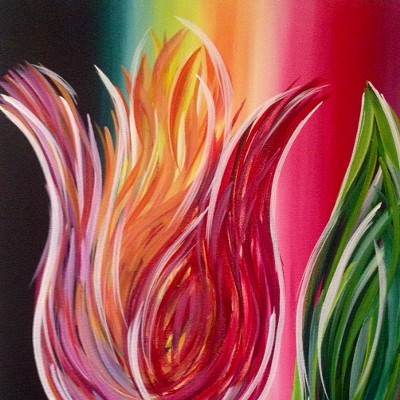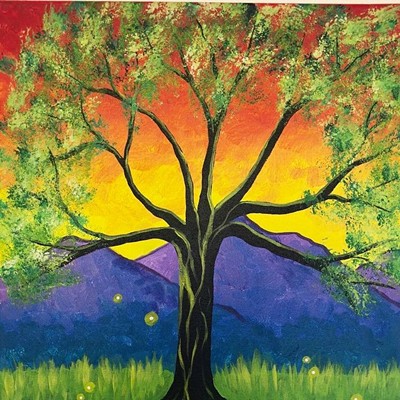The first half of the gallery's annual summer invitational--Part II, opening later this month, will not surprisingly tackle Fauna--Flora is a mixed-media garden. Painting, fabric, ceramics, wood sculpture, jewelry and more, by 44 artists, are all part of the mixed bouquet. The artists are from all around the country, but Tucsonans make a fine showing.
Some, like the Tucson Weekly's own Rand Carlson, have placed their flowers in a landscape. "Successor," Carlson's cheerfully accessible work in chopped-up colored tile, pictures a bounteous saguaro against blue sky, green mountains and yellow ochre desert. The white flowers atop each saguaro arm are arrayed like stars against the firmament.
Longtime Tucson painter Judith D'Agostino, who now heads the education department at the Tucson Museum of Art, has also contributed a whole landscape. Framed in two pieces like a work of medieval religious art, the shiny painting nevertheless glorifies not God but the golden land. The painter's sky, a delicate assemblage of pink and yellow clouds, overlooks a winding valley and mountains brilliant in gold leaf.
Julie Sasse, the TMA curator who recently organized the Arizona Biennial '01, gets a chance here to show off her own work. She took the assignment to work in Flora as seriously as D'Agostino did, and contributed a lovely, loose mixed-media painting. "Sara's Quest" combines a painted postcard of mountains and sky with a fragment of real plant glued to a golden screen. The whole thing is held together by a piece of organic paper--a handmade purple affair that reminds us that even art's papers have their source in the world of plants.
Judith Golden is a retired UA prof and a photographer famous for, among other things, portraits of a young girl in lushly colored forests and gardens. But here she has abandoned color. "In My Garden" is a spare "photogram" of a few flowers, their stems and leaves; these elements appear like a silvery apparition against the deep black of the background. In stripping the flower of its color--what we usually think of as a blossom's essential element--Golden has somehow made it more itself than before.
But some artists just want to have fun with Flora. Karen Shapiro's "Miracle Carrot" is a realistic cone of orange ceramic about two feet long, topped by green leaves. The artist has also included the source of the monster carrot's power: Miracle Gro for Carrots. The Miracale Gro box, also in ceramic, has directions advising prospective gardeners to "mix with water, apply, stand back!" Tom Kerrigan has made a sculpture that's half prickly pear pad, half rattlesnake's eye.
David Aguirre and Nora Kuehl, the latter the former director of Dinnerware Contemporary Art Gallery, collaborated on another humorous clay piece. "Viva Tierra," like many of Aguirre's strangely animalistic humans, is a combination of two species, but this time the creature is a Plant Man. A human torso grows out of a finely crenellated tree trunk in orange; green leaves grow out of its head. Plant Man's face bears a serene expression, his eyes peacefully closed, hinting at a deeper meaning: Humans are happiest when they're in harmony with nature. Or at the very least, when they're out cultivating their gardens.














